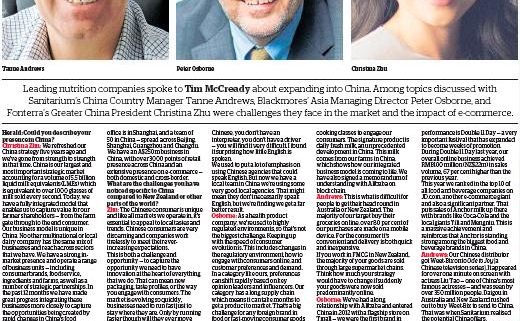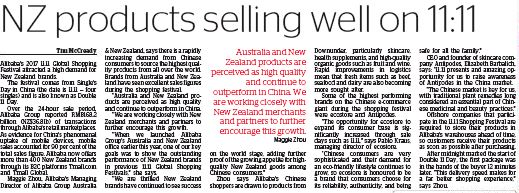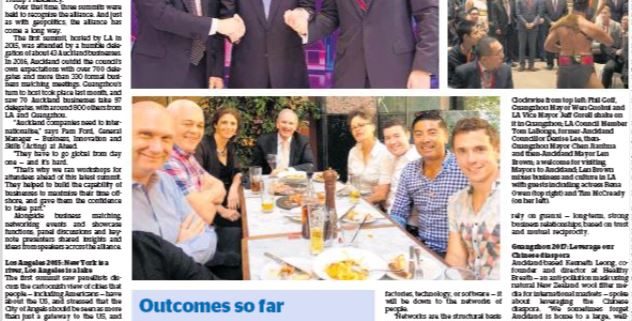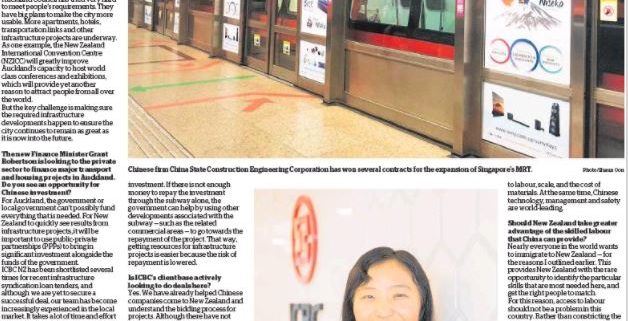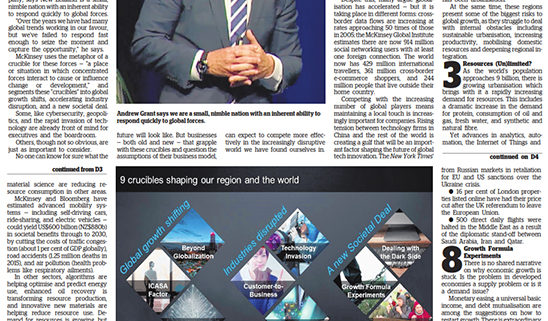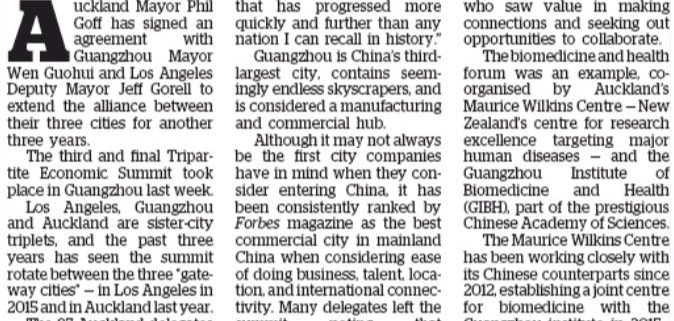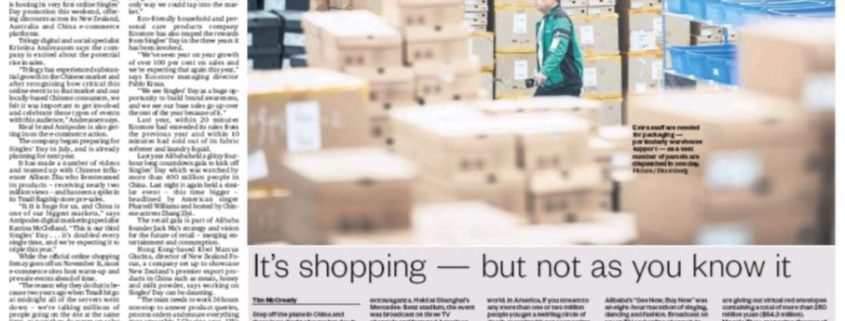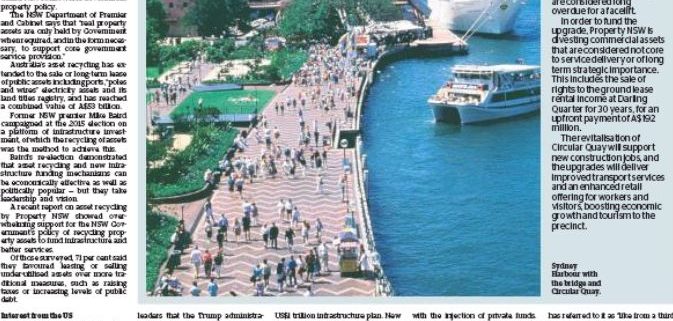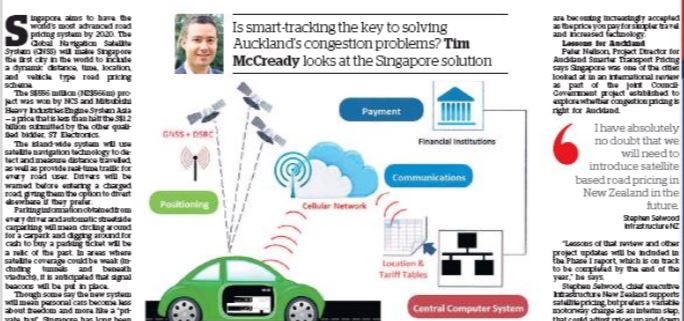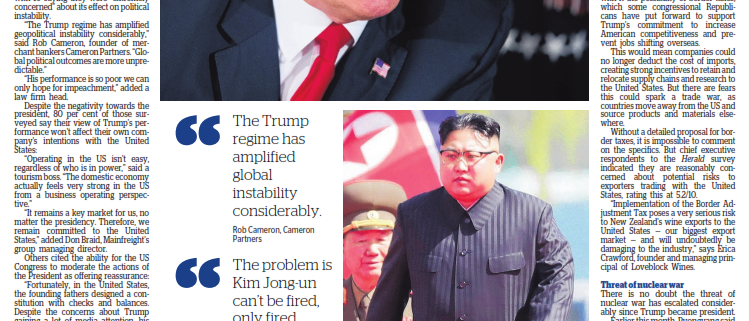China Business: Tapping into the food chain (NZ Herald)
Leading nutrition companies spoke to Tim McCready about expanding into China. Among topics discussed with Sanitarium’s China Country Manager Tanne Andrews, Blackmores’ Asia Managing Director Peter Osborne, and Fonterra’s Greater China President Christina Zhu were challenges they face in the market and the impact of e-commerce.
Herald: Could you describe your presence in China?
Christina Zhu: We refreshed our China strategy five years ago and we’ve gone from strength to strength in that time. China is our largest and most important strategic market accounting for a volume of 5.5 billion liquid milk equivalents (LMEs) which is equivalent to over 1000 glasses of milk sold every second. Today, we have a fully integrated model that enables us to capture value for our farmer shareholders — from the farm gate through to the end consumer.
Our business model is unique in China. No other multinational or local dairy company has the same mix of businesses and reach across sectors that we have. We have a strong in-market presence and operate a range of business units — including consumer brands, foodservice, ingredients and farms, as well as a number of strategic partnerships. In the past 12 months we have made great progress integrating these businesses more closely to capture the opportunities being created by rapid changes in China’s food industry, such as growing household affluence, demographic changes in the population and the rapid growth of technology and e-commerce.
We are the market leader in food service, Anchor is the number one imported milk brand both online and offline, we have around 35,000 cows producing a significant amount of milk each year and we are a leading supplier of dairy ingredients to major international and local food companies in China.
At the same time we are Fonterra’s biggest employer off-shore with close to 1700 people in the greater China region (mainland China, Hong Kong and Taiwan).
Tanne Andrew: We’ve been an export business into China for about five years, and have had a functional office in China for about the past 18 months.
Chinese consumers increasingly want to try things from the West and there is massive growth in breakfast cereal in China. We are building trust in Sanitarium’s brand, which we want to expand on. Light ‘n’ Tasty will likely be the next product we bring to the China market.
Peter Osborne: We’ve been here since 2012. We have a wholly-owned foreign enterprise in Beijing, our head office is in Shanghai, and a team of 50 in China — spread across Beijing, Shanghai, Guangzhou and Chengdu. We have an A$250m business in China, with over 3000 points of retail presence across China and an extensive presence on e-commerce — both domestic and cross-border.
What are the challenges you have noticed specific to China compared to New Zealand or other parts of the world?
Zhu: The Chinese consumer is unique and like all markets we operate in, it’s essential to appeal to local tastes and trends. Chinese consumers are very discerning and companies work tirelessly to meet their ever-increasing expectations.
This is both a challenge and opportunity — to capture the opportunity we need to have innovation at the heart of everything that we do. That can mean new packaging, taste profiles, or the way you engage with consumers. The market is evolving so quickly, businesses need to run fast just to stay where they are. Only by running faster though will they ever move ahead.
One area where we have really captured the essence of innovation is through our foodservice business — Anchor Food Professionals. The dairy beverage category is rapidly expanding and we’ve been able to capitalise on this trend by working with our customers to create innovative taste sensations, such as the tea macchiato. This is made using a blend of flavoured Chinese tea with a creamy cap of whipped cream and cream cheese.
Thanks to innovations like this, we are now selling around 80 million drinks per year and this is growing rapidly.
Andrews: While the opportunities in China are big, the challenges are also big. China is not the easiest place in the world to do business — complicated sales channels, language barriers, different consumer laws, professional shoppers — these are just a few of the challenges you face that you don’t have to worry about in your own domestic market.
China is very different to Australia and New Zealand — it’s the antithesis really, when you look at lifestyle. And it is extremely fast-paced. Everything changes so quickly, it’s like a different planet and you have to keep up.
As an ex-pat, if you can’t speak Chinese, you don’t have an interpreter, you don’t have a driver — you will find it very difficult. I found it surprising how little English is spoken.
We used to put a lot of emphasis on using Chinese agencies that could speak English. But now we have a local team in China we’re using some very good local agencies. That might mean they don’t necessarily speak English, but we’re finding we get a far better result.
Osborne: As a health product company, we’re used to highly regulated environments, so that’s not the biggest challenge. Keeping up with the speed of consumer evolution is.
This includes changes in the regulatory environment, how to engage with consumers online, and customer preferences and demand.
In a category like ours, preferences can shift rapidly based on key opinion leaders and influencers. Our category has a long supply chain which means it can take months to get a product to market. That’s a big challenge for any foreign brand in food or fast-moving consumer goods (FMCG).
How are you currently using e-commerce in China?
Zhu: E-commerce in China is such an important platform and it’s moving at a rapid pace.
We’re really capturing this opportunity — over half of our consumer business is online and Anchor is the number one imported dairy brand both on and offline in China.
Our strategic partnership with Alibaba is helping us deliver significant growth. Alibaba has created a huge digital ecosystem in China encompassing all online channels and we’re working in partnership with them to get more and more of our products to consumers across China. For example, Tmall.com, Alibaba’s online retail market place, is an extremely important channel for us, and enables retailers to sell Anchor, Anlene and Anmum to consumers.
A key development in the China e-commerce landscape has been the growing integration of online and offline channels — or what people are calling ‘new retail’. This year we launched a partnership with Hema — Alibaba’s supermarket chain — where we will sell our current product range, launch new products and offer cooking classes to engage our consumers. The signature product is daily fresh milk, an unprecedented development in China. This milk comes from our farms in China, which shows how our integrated business model is coming to life. We have also signed a memorandum of understanding with Alibaba on blockchain.
Andrews: This is what is difficult for people to get their head round in Australia or New Zealand. The majority of our target buy their groceries on line, over 80 per cent of our purchases are made on a mobile device. For the consumer it’s convenient and delivery is both quick and inexpensive.
If you work in FMCG in New Zealand, the majority of your goods are sold through large supermarket chains. Think how much your strategy would have to change if suddenly your goods were now sold predominantly online.
Osborne: We’ve had a long relationship with Alibaba and entered China in 2012 with a flagship store on Tmall — we were the first brand in our category to have a Tmall store.
We sell on various Alibaba platforms — Tmall, Tmall Choice, AliHealth, Taobao — and we also work with them on big strategic projects including a blockchain project for food safety and a Global Healthcare Initiative with Tmall. We have a deep relationship with them, which has really helped drive our business in China.
Online and cross-border e-commerce is a big part of our business, and Double 11 Day is a big feature of the yearly calendar. We work up to it with a range of activations — it is about consumer engagement and brand awareness as much as it is about sales. For a long-term business in China this is important, because it allows you to keep engaging with your consumers.
We did a three-hour livestream prior to Double 11 Day. We used Chinese celebrities and Chinese pop-stars as part of a broader programme produced by Hunan Television [a satellite TV station]. At its peak we had 480,000 people online viewing our livestream and we added 13,000 fans to our flagship store.
Can you give an example of an online success you had in China?
Zhu: One example of our online performance is Double 11 Day — a very important festival that has expanded to become weeks of promotion. During Double 11 Day last year, our overall online business achieved RMB100 million (NZ$22m) in sales volume, 67 per cent higher than the previous year.
This year we ranked in the top 10 of all food and beverage companies on JD.com, another e-commerce giant and also a significant partner. That puts sales of Anchor milk up there with brands like Coca-Cola and the local giants Yili and Mengniu. This is a massive achievement and reinforces that Anchor is standing strong among the biggest food and beverage brands in China.
Andrews: Our Chinese distributor got Weet-Bix onto Ode to Joy [a Chinese television series]. It appeared for over one minute on screen with actress Liu Tao — one of China’s most famous actresses — and was seen by over 350 million people. Daigou in Australia and New Zealand rushed out to buy Weet-Bix to send to China. That was when Sanitarium realised the potential China offers.
Since then, due to a trademark battle, we have had to rebrand in China to Nutri-Brex.
But Nutri-Brex retains the Weet-Bix colours and branding. It is selling very well, and the bonus for us is that Daigou don’t have access to Nutri-Brex as it is exclusive to China.
This gives Sanitarium more control over the Chinese market and eliminates problems associated with parallel imports.
Osborne: We learnt a very good lesson in China from our vitamin E cream — a product we have been selling for 30 years.
There was some social media chatter two years ago that Fan Bingbing — a very famous Chinese actress — was using our vitamin E product. Our sales went from 3000 tubes a month to one million tubes a month.
This really had very little to do with us — but we had to crank up production rapidly to meet this demand we hadn’t anticipated, all because of social media which is so dynamic in China.
Although things have calmed down now from that peak, we are still selling considerably more vitamin E cream than we used to — up into the hundreds of thousands of tubes a month.

